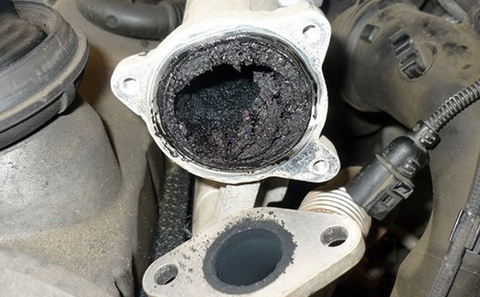Author: SPELAB Mechanical Engineer (focusing on car modification for 10 years)
1. Reducing Tailpipe Emissions
In recent years, the UK has been very concerned about climate change. According to the UK Environmental Accounts from the Office for National Statistics, 21% of the UK's 2017 greenhouse gas emissions (GHG emissions) were attributable to exhaust emissions from motor vehicles.
To reduce the amount of GHG emissions from vehicle transportation, regulations are growing stricter. To comply with the strict requirements, automakers must modify the designs of their automobiles.
Utilizing after-treatment equipment is one way to lower exhaust pollutants. Exhaust Gas Recirculation (EGR) systems are incorporated into the majority of modern vehicles. But what exactly is an EGR?

2. How the EGR System Works
2.1 What does EGR stand for?
Exhaust Gas Recirculation (EGR) is used in modern internal combustion engines to regulate Nitrogen Oxide (NOx) emissions, which are created as a byproduct during combustion.
When fuel and air from the environment, primarily an oxygen and nitrogen mixture, combine inside the combustion chamber and ignite, temperatures rise, and NOx emissions are produced.
By returning a tiny amount of exhaust gas to the engine's combustion chambers through the intake manifold, the EGR system lowers combustion temperatures and thereby lowers NOx emissions.
2.2 Nitrogen Oxide (NOx)
Major smog contributor NOx can be harmful to human health, ecosystems, and agricultural crops in addition to other pollutants.In order to reduce hazardous emissions, protect the environment, and improve human health, EGR systems must be incorporated into automotive designs.
2.3 What Is an EGR Valve and What Does It Do?
The EGR system's key component is the EGR valve, which controls the flow of exhaust gases recirculated into the engine's intake system. This process helps vehicles comply with strict emissions laws by reducing nitrogen oxide (NOx) emissions.
The EGR valve works by returning a portion of the exhaust gases back into the combustion chamber to mix with fresh intake air. This reduces the oxygen concentration and increases the water vapor content in the combustion mixture, which lowers the peak combustion temperature—directly decreasing the formation of NOx.
The valve itself is typically closed and only opens under specific engine conditions. After the engine has started, reached its optimal operating temperature, and the vehicle begins accelerating, the EGR valve gradually opens to allow exhaust gas recirculation. It is controlled by either a vacuum actuator or an electronic step motor, depending on the engine design.
Once the vehicle slows down or the engine is turned off, the valve returns to its closed position, stopping the flow of exhaust gases.
3. Problems with an EGR valve
Common Signs of a Bad or Failing EGR Valve
Over time, EGR valves can develop issues—most commonly due to carbon buildup from unburned fuel particles. This can cause the valve to stick open or closed, disrupting the proper flow of exhaust gases and triggering a range of performance and emission problems.
3.1 Mechanical symptoms:
-
EGR valve or its passages may become completely clogged, halting exhaust gas recirculation altogether
-
The valve can get stuck in either the open or closed position, leading to unstable engine operation
3.2 Performance-related symptoms:
-
Noticeable drop in engine performance, especially under load
-
Increased fuel consumption due to inefficient combustion
-
Engine hesitation or rough idling
3.3 Exhaust & emissions signs:
-
Black smoke from the tailpipe during acceleration
-
Strong fuel smell inside or around the vehicle, caused by unburned hydrocarbons exiting the exhaust system
3.4 Electronic alerts:
-
The Check Engine Light (CEL) will illuminate if the EGR valve fails to operate correctly
Due to the odor’s intensity and potential health impact, a strong fuel smell is a particularly recognizable and concerning symptom.
4. EGR valve and a MOT test
In the past, many car owners chose to remove the EGR valve or Diesel Particulate Filters (DPFs) to avoid the high EGR valve replacement cost and maintenance hassles. In some cases, drivers misunderstood early signs of a faulty EGR valve, such as reduced engine performance or black smoke, and opted for deletion over repair.
However, under current UK law, particularly for vehicles meeting Euro 6 Emissions Standards, such removals are illegal. The Department for Transport mandates that all original emissions systems remain intact for road-legal operation.
❗ Will removing the EGR valve cause an MOT failure?
Absolutely. If the EGR system or DPF is missing or tampered with, the vehicle will fail its MOT test due to non-compliance with emissions regulations.
Additionally, driving a vehicle with a deleted EGR valve on public roads could result in a £1,000 fine, and the car will be deemed unroadworthy. It may also lead to invalid insurance or impact vehicle resale value.
💡 Replacing the EGR valve with a compliant unit is the only legal solution. While EGR valve price can vary depending on the make and model, repair is far less risky than potential fines or MOT failure. If you're unsure whether your valve is failing, consider learning how to test an EGR valve using a vacuum test or scan tool before committing to replacement.

5. How to Test an EGR Valve
If you're experiencing symptoms of a bad EGR valve—such as rough idling, black smoke, or decreased fuel economy—it's important to confirm the issue before replacing the part.
Here are a few basic methods to test an EGR valve:
1. Visual Inspection
Remove the valve and inspect for excessive carbon buildup, stuck components, or damage.
2. Manual Vacuum Test (for vacuum-operated EGR valves)
Use a hand-held vacuum pump. Apply vacuum to the valve and observe:
-
If the diaphragm holds vacuum → the valve is likely functioning.
-
If it fails to hold vacuum → the valve may be faulty.
3. OBD2 Scanner Test
Use an OBD2 scan tool to check for error codes related to the EGR system (e.g., P0401, P0402). Live data monitoring may also show whether the valve opens under proper engine load.
If you're unsure how to interpret the results, consult a technician or visit a certified garage before moving forward with replacement.
6. Concerned about your vehicle's EGR valve?
Despite its relatively high replacement cost, an EGR valve is an essential component in reducing harmful NOx emissions and helping your vehicle comply with modern emissions standards.
If you're noticing signs such as rough idling, reduced engine performance, black smoke, or a strong fuel smell, it could indicate a problem with the EGR valve.
You can schedule a free vehicle health check at your local Evans Halshaw retailer to determine whether cleaning, repair, or replacement is needed.
In some cases, EGR valve cleaners may help if the valve is not fully clogged. However, if the issue persists, replacing the EGR valve may be necessary to restore proper engine function and pass your MOT test.
7. Do EGR valve cleaners work?
If your EGR valve is still functioning and not fully blocked, using a cleaner won’t do any harm—and it might even leave you feeling better knowing things are running a bit cleaner inside your engine.
That said, if the valve is already clogged with carbon deposits, nothing is likely to get through—certainly not the cleaner, unless it comes with a team of Wynn’s fluid-teleporting fairies.
In general, EGR valve cleaners are most effective as a preventive measure or for mild-to-moderate buildup. If your vehicle is already showing severe symptoms (like black smoke, poor idling, or a check engine light), it may be too late for a cleaner to make a difference. In such cases, manual cleaning or replacement may be necessary.
8. What Is an EGR Delete and Why Do People Do It?
A vehicle's EGR valve is removed with the aid of an aftermarket performance kit during an exhaust gas recirculation (EGR) system delete to stop exhaust gases from being directed into the engine. When this occurs, it has an impact on the engine's performance in a number of ways.

Many enthusiasts choose an EGR delete to improve engine reliability and performance—especially in diesel engines. By eliminating the flow of exhaust gases into the intake, the system stays cleaner, reducing the buildup of carbon deposits that can clog intake ports and valves. This can lead to smoother engine operation, more consistent power delivery, and, in some cases, improved fuel efficiency.
EGR deletes are particularly popular in off-road or competition vehicles where emission regulations don’t apply. However, it's important to note that removing emissions components may not be legal for on-road use in some regions and could affect MOT compliance or vehicle warranty.
9. What does an EGR delete kit do for a 6.0 Powerstroke?
Disabling the EGR system on a 6.0L Power Stroke engine can lead to an increase in exhaust gas temperature. This happens because, under normal operation, exhaust gases are recirculated back into the intake to help reduce combustion temperature and control emissions.
With an EGR delete kit installed, that cycle is interrupted, and all exhaust gases exit through the turbo and exhaust system. While this can reduce carbon buildup and eliminate EGR-related failures, it also means higher temperatures under load. In some setups, owners may install exhaust gas temperature gauges to keep things in check.
10. FAQ
1. What exactly does EGR mean in a car?
EGR stands for Exhaust Gas Recirculation. It’s a system that helps reduce harmful nitrogen oxide (NOx) emissions by recirculating some of the exhaust gases back into the engine’s intake.
2. Why is my car showing signs of EGR trouble?
If you're noticing rough idling, black smoke, loss of power, or poor fuel economy, your EGR valve could be sticking or clogged. A check engine light often accompanies these symptoms.
3. Can I check my EGR valve myself?
Yes. You can inspect it manually for carbon buildup, use a vacuum pump to test its movement (if vacuum-operated), or plug in an OBD2 scanner to look for related error codes.
4. Do EGR valve cleaners actually make a difference?
They can, but mostly in early stages of buildup. If your valve isn’t fully clogged, a cleaner can help restore flow. Otherwise, manual cleaning or replacement is more effective.
5. What’s the benefit of deleting the EGR system?
Removing the EGR system can reduce carbon buildup, simplify engine operation, and improve throttle response. It's especially popular on diesel engines used for off-road or competition purposes.
6. Will deleting my EGR valve cause issues with the MOT?
Yes. In the UK and many other countries, deleting emissions equipment like the EGR valve will cause your vehicle to fail the MOT and may result in legal penalties.
7. How much should I expect to pay for an EGR valve replacement?
Prices can vary, but typical EGR valve replacement costs range from £150 to £400, depending on vehicle type and labor fees.
8. Should I clean or replace a faulty EGR valve?
If the valve is only mildly clogged, cleaning might work. But if performance issues persist or the valve is damaged, replacement is usually the more reliable solution.






